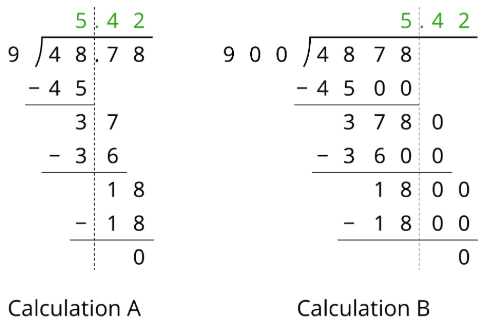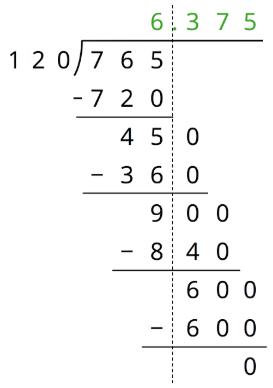29.5: Dividing Decimals by Decimals
- Page ID
- 40306
Lesson
Let's divide decimals by decimals.
Exercise \(\PageIndex{1}\): Same Values
- Use long division to find the value of \(5.04\div 7\).
- Select all of the quotients that have the same value as \(5.04\div 7\). Be prepared to explain how you know.
- \(5.04\div 70\)
- \(50.4\div 70\)
- \(504,000\div 700\)
- \(504,000\div 700,000\)
Exercise \(\PageIndex{2}\): Placing Decimal Points in Quotients
- Think of one or more ways to find \(3\div 0.12\). Show your reasoning.
- Find \(1.8\div 0.004\). Show your reasoning. If you get stuck, think about what equivalent division expression you could write.
- Diego said, “To divide decimals, we can start by moving the decimal point in both the dividend and divisor by the same number of places and in the same direction. Then we find the quotient of the resulting numbers.”
Do you agree with Diego? Use the division expression \(7.5\div 1.25\) to support your answer.
Are you ready for more?
Can we create an equivalent division expression by multiplying both the dividend and divisor by a number that is not a multiple of 10 (for example: 4, 20, or \(\frac{1}{2}\))? Would doing so produce the same quotient? Explain or show your reasoning.
Exercise \(\PageIndex{3}\): Two Ways to Calculate Quotients of Decimals
- Here are two calculations of \(48.78\div 9\). Work with your partner to answer the following questions.

- How are the two calculations the same? How are they different?
- Look at Calculation A. Explain how you can tell that the 36 means “36 tenths” and the 18 means “18 hundredths.”
- Look at Calculation B. What do the 3600 and 1800 mean?
- We can think of \(48.78\div 9=5.42\) as saying, “There are 9 groups of 5.42 in 48.78.” We can think of \(4878\div 900=5.42\) as saying, “There are 900 groups of 5.42 in 4878.” How might we show that both statements are true?
-
- Explain why \(51.2\div 6.4\) has the same value as \(5.12\div 0.64\).
- Write a division expression that has the same value as \(51.2\div 6.4\) but is easier to use to find the value. Then, find the value using long division.
Exercise \(\PageIndex{4}\): Practicing Division with Decimals
Find each quotient. Discuss your quotients with your group and agree on the correct answers. Consult your teacher if the group can't agree.
- \(106.5\div 3\)
- \(58.8\div 0.7\)
- \(257.4\div 1.1\)
- Mai is making friendship bracelets. Each bracelet is made from 24.3 cm of string. If she has 170.1 cm of string, how many bracelets can she make? Explain or show your reasoning.
Summary
One way to find a quotient of two decimals is to multiply each decimal by a power of 10 so that both products are whole numbers.
If we multiply both decimals by the same power of 10, this does not change the value of the quotient. For example, the quotient \(7.65\div 1.2\) can be found by multiplying the two decimals by 10 (or by 100) and instead finding \(76.5\div 12\) or \(765\div 120\).
To calculate \(765\div 120\), which is equivalent to \(76.5\div 12\), we could use base-ten diagrams, partial quotients, or long division. Here is the calculation with long division:

Glossary Entries
Definition: Long Division
Long division is a way to show the steps for dividing numbers in decimal form. It finds the quotient one digit at a time, from left to right.
For example, here is the long division for \(57\div 4\).

Practice
Exercise \(\PageIndex{5}\)
A student said, “To find the value of \(109.2\div 6\), I can divide 1,092 by 60.”
- Do you agree with her? Explain your reasoning.
- Calculate the quotient of \(109.2\div 6\) using any method of your choice.
Exercise \(\PageIndex{6}\)
Here is how Han found \(31.59\div 13\):

- At the second step, Han subtracts 52 from 55. How do you know that these numbers represent tenths?
- At the third step, Han subtracts 39 from 39. How do you know that these numbers represent hundredths?
- Check that Han’s answer is correct by calculating the product of 2.43 and 13.
Exercise \(\PageIndex{7}\)
- Write two division expressions that have the same value as \(61.12\div 3.2\).
- Find the value of \(61.12\div 3.2\). Show your reasoning.
Exercise \(\PageIndex{8}\)
A bag of pennies weighs 5.1 kilograms. Each penny weighs 2.5 grams. About how many pennies are in the bag?
- \(20\)
- \(200\)
- \(2,000\)
- \(20,000\)
Exercise \(\PageIndex{9}\)
Find each difference. If you get stuck, consider drawing a diagram.
\(2.5-1.6\qquad 0.72-0.4\qquad 11.3-1.75\qquad 73-1.3\)
(From Unit 5.2.3)
Exercise \(\PageIndex{10}\)
Plant B is \(6\frac{2}{3}\) inches tall. Plant C is \(4\frac{4}{15}\) inches tall. Complete the sentences and show your reasoning.
- Plant C is _______ times as tall as Plant B.
- Plant C is _______ inches ____________ (taller or shorter) than Plant B.
(From Unit 4.4.1)
Exercise \(\PageIndex{11}\)
At a school, 460 of the students walk to school.
- The number of students who take public transit is 20% of the number of students who walk. How many students take public transit?
- The number of students who bike to school is 5% of the number of students who walk. How many students bike to school?
- The number of students who ride the school bus is 110% of the number of students who walk. How many students ride the school bus?
(From Unit 3.4.6)

